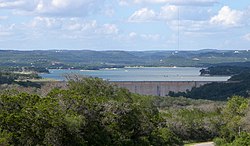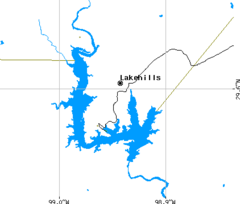Medina Lake
| Medina Lake | |
|---|---|

Medina Lake
|
|

Map
|
|
| Location | Bandera / Medina counties, Texas, US |
| Coordinates | 29°32′25″N 98°56′01″W / 29.54028°N 98.93361°WCoordinates: 29°32′25″N 98°56′01″W / 29.54028°N 98.93361°W |
| Lake type | Agricultural reservoir |
| Primary inflows | Medina River |
| Primary outflows | Medina River |
| Basin countries | United States |
| Surface area | 6,060 acres (2,450 ha) |
| Max. depth | 152 ft (46 m) |
| Shore length1 | 110 mi (180 km) |
| Surface elevation | 1,062 ft (324 m) |
| 1 Shore length is not a well-defined measure. | |
Medina Lake is a reservoir on the Medina River in the Texas Hill Country of the United States. It is operated by the Bexar/Medina/Atascosa County Agricultural District. Medina Dam was completed in 1913 in a privately financed project, creating the lake to supply irrigation water for local agricultural use. Lake Medina is in northeastern Medina County, and southeastern Bandera County, about 40 miles (64 km) northwest of San Antonio.
It is a crescent-shaped reservoir running west to east. It is 18 miles (29 km) long and 3 miles (5 km) wide at its broadest point. It is contained by the Medina Dam at the lake's south end. At the time of the dam's construction, it was the largest concrete dam in the country and the fourth largest dam overall. The dam is listed on the National Register of Historic Places.
The lake is fed by and discharges back into the Medina River, and serves both recreational and irrigation uses. Communities located along the lake are Mico, Lake Medina Shores and Lakehills.
There is also a Lake Medina east of Medina, Ohio, which recently was made a county park.
Medina Lake has been stocked with species of fish intended to improve the reservoir for recreational fishing. Fish in Medina Lake include largemouth bass, white bass, hybrid striped bass, catfish, and carp. Due to drought conditions lasting up until July 2015, recreational fish species had disappeared. Plans to restock the lake once levels reach viable levels were put in place. These plans were realized when the lake did reach these levels, which as of October 2, 2016, is 96.6% full.
...
Wikipedia
